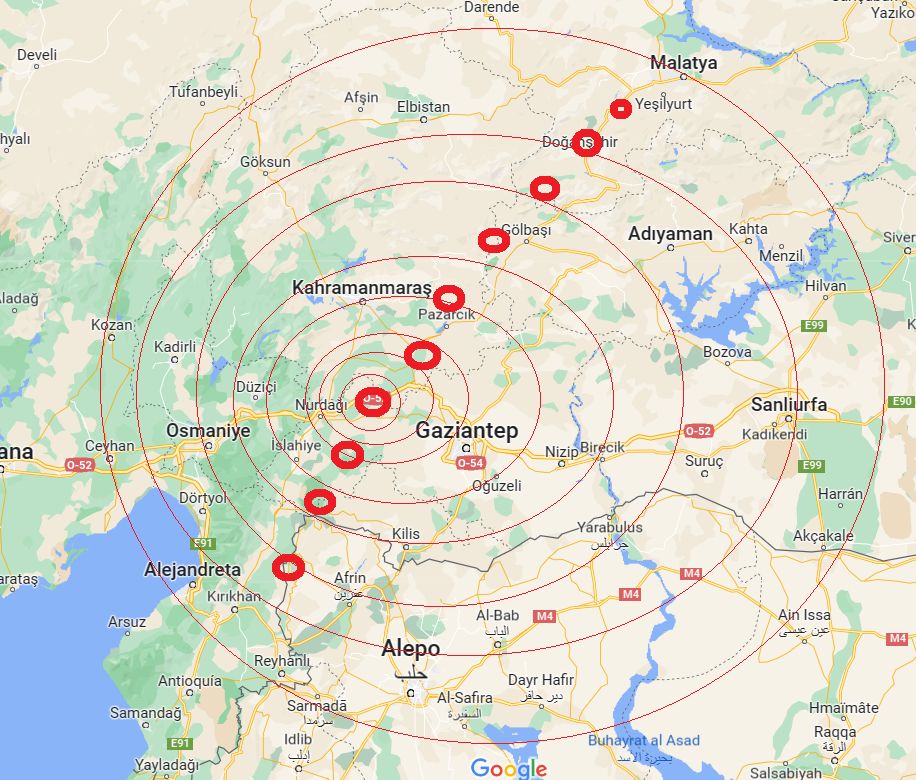Short description of the events in the morning of February 6, 2023 in the southern area of Turkey and northern Syria
The February 2023 earthquake in Turkey and Syria is a calamitous event that occurred on the night between February 5 and 6, 2023, mainly by means of two strong tremors that struck the southern part of Turkey, as well as the regions of northern Syria.
A first earthquake, with a hypocenter at a depth of about 17.9 km and an epicenter 34 km northwest of the city of Gaziantep (about 90 km from the border with Syria), as well as 26 km west of Nurdağı, recorded a magnitude of 7.8 MWW, followed by dozens of other aftershocks.
Subsequently, a second earthquake, with a magnitude of 7.5 MWW and epicenter located 4 km south of the city of Ekinözü, mainly affected the territory of Kahramanmaraş province.
According to estimates made by the two countries mainly involved, the earthquake caused a total of more than 12,000 victims, while more than 37,000 were injured.
Seismicity
Despite the relative seismic inactivity of the epicentral area of the earthquake, due to its geological features, southern Turkey and northern Syria have experienced significant and damaging earthquakes in the past: among them, the Aleppo earthquakes of 1138 (7.1 Mww) and 1822 (7.0-7.4 Mww). The latter in particular, killed 68% of the population at the time.
In addition, the epicenter of the earthquake is near a triple junction between the margins of the Anatolian plate (in Turkish territory), the Arabian plate (where almost all of Syria is located) and the African plate: the movements that affecting these three plates make this area highly dangerous seismically speaking, among the highest detected in territories overlooking the Mediterranean Sea.
According to estimates, the initial shock occurred at the northern end of the zone between the East Anatolian fault, which includes the entire Turkish coastal region in front of the Aegean Sea and formed precisely following the movements of the plates before mentioned, and the just-bordering Dead Sea Fault, which consists of a series of transform faults that extend from the aforementioned Eastern Anatolian fault, laterally cross the Arabian plate and reach the northern edges of the Red Sea
Therefore, the earthquake would have created a fracture in one of the two faults, affecting a segment about 190 km long and about 25 km wide. As is often the case with tremors of such high intensity and magnitude, it is plausible that a fault of dimensions equal to a few hundred square kilometers has been activated: therefore, the hypocenter of the earthquake, recorded here at a depth of about 17.9 km coincides with the point on the fault plane from which the rupture and displacement of the fault began.
Earthquake
On February 6, 2023, two powerful earthquakes struck southern and central Turkey. The first earthquake occurred northwest of the city of Gaziantep at 04:17 local time (01:17 UTC), causing widespread damage in Turkey and Syria. Having recorded a maximum Mercalli intensity of IX (destructive shock) and a magnitude of 7.8 Mww, the shock was the most devastating for Turkey since the 1999 İzmit earthquake (7, 6 Mww), as well as the strongest in the country’s history, comparable to the 1939 Erzincan earthquake.
The earthquake was followed by several aftershocks, the strongest of which had a magnitude of 6.7 Mww and was recorded southeast of Nurdağı. The second earthquake happened about nine hours after the first, at 13:24 local time (10:24 UTC), with its epicenter located 4 km south of Ekinözü in Kahramanmaraş province: it also recorded a maximum intensity of Mercalli of IX, reporting a magnitude of 7.5 Mww.
The situation of the earthquakes recorded since February 6, 2023 is shown graphically below:


Information taken from Wikipedia
